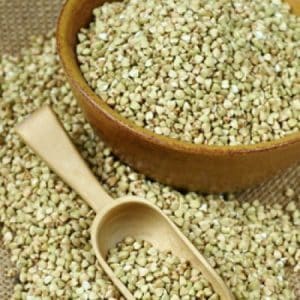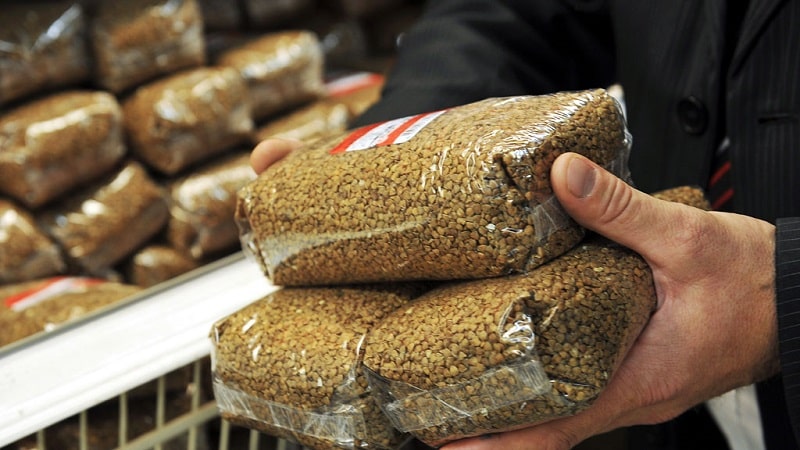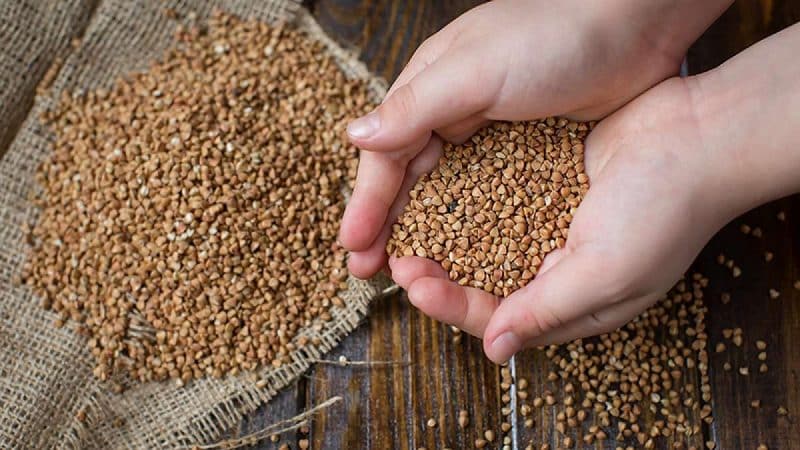Choosing the right grain: which buckwheat is better, dark or light, what criteria to pay attention to
Buckwheat is a cereal that is popular and loved by many. It contains useful vitamins and minerals and saturates the body for a long time.
The modern market offers different varieties of this cereal. They differ in appearance, benefit and price. Fans of this product know which buckwheat is better - dark or light. Let us tell you in more detail what they pay attention to when choosing this cereal.
What is the difference between dark and light buckwheat?
Dark and light buckwheat are not different varieties. Brown color and all its shades are from steamed grains. The beneficial properties are reduced because it is processed at high temperatures. It cooks quickly, the porridge turns out crumbly, with a delicate taste.
If the color is dark brown, then there is very little useful stuff left in it. Such kernels are most often processed in small farms. Instead of steaming, they are fried.
 Pale, cream color with a slight tinge of yellow in unparboiled grain cereals. Useful properties are preserved in it as much as possible. It takes longer to cook dark.
Pale, cream color with a slight tinge of yellow in unparboiled grain cereals. Useful properties are preserved in it as much as possible. It takes longer to cook dark.
The color of buckwheat depends on the processing temperature. At high temperatures it turns brown. When fried it turns dark brown. Light grains are not steamed.
Which one is better and what
The answer to this question seems obvious. If there are more beneficial properties in light cereals, then it means it is better.
Pros of dark buckwheat:
- cooks faster;
- crumbly;
- the taste is more delicate;
- low price.
Pros of light buckwheat:
- more useful elements;
- Suitable for garnish.

There is a large assortment of dark and light cereals on sale. If the issue is price, then choose the first one - it is cheaper. Proponents of a healthy lifestyle prefer light colors.
Which buckwheat is better: brown or green?
The most useful buckwheat - green. During purification, grains are not subjected to heat treatment, so all vitamins and microelements remain in full. This is a natural product. It is consumed raw.
Interesting. In Europe, green buckwheat can only be bought in pharmacies, as it is considered medicinal and dietary product.
Methods for preparing green buckwheat:
- germination;
- steaming.
They germinate it, following certain rules.
The process consists of soaking the cereal in melt or glacial water. The grains remain in the first water for no more than 1.5 hours. Then the water is changed and left for 4 to 10 hours, stirred and when mucus appears, the water is changed again. Grains require different amounts of time to germinate. Therefore, the total time of this process takes from 8 to 24 hours.
The most useful cereal is considered to be 2-4 days after the sprouts appear.
Attention! Store sprouted grains in the refrigerator for no more than five days.
Proponents of a healthy diet have come up with many dishes with sprouted green buckwheat. They make porridge with fruits, salads, dry sprouted grains and grind them into flour. Hence pancakes, pancakes, pies - healthy baked goods that do not contain yeast or oil.
An easier, but no less healthy way to prepare green buckwheat is steaming. Everything is simple here. One glass of grain pour two glasses of boiling water overnight. Don't forget to rinse the cereal first.
In second place is the kernel, which is obtained from buckwheat by grinding it. During processing, the shell is separated. The next stage is steaming or frying.
Brown cereals are obtained by intensely frying the kernels; the composition of vitamins and microelements is significantly reduced. Brown buckwheat is boiled and soaked.
Cold water, boiling water, kefir are suitable for soaking. The main thing is to maintain the correct proportions: for one glass of grain - two glasses of liquid. Cold water leaves maximum benefits. Soak overnight and be sure to eat during the day. When soaked in boiling water, the amount of vitamins decreases. But by morning the cereal turns out crumbly, like porridge.
Nutritionists advise soaking buckwheat with low-fat kefir. It is recommended to pour the mixture into a thermos so that the cool drink does not ferment overnight in a warm room.
How to choose the best buckwheat

Manufacturers often confuse customers. Advertising on television and colorful packaging are misleading for many. when choosing cereals. Let's consider this issue in more detail.
Types and varieties of buckwheat
Buckwheat comes in two types:
- Yadritsa - whole grain.
- Done - split grains, small and large. The simple name is chop.
Only the kernel is divided into varieties.
The first one is the purest and highest quality. Minimum of unprocessed grain, small litter.
Interesting. In the East, tea is made from buckwheat grains.
The second one contains up to 7% waste after processing.
The third - up to 10% of various impurities.
The variety does not affect the quality of the cereal. The third grade has a lower price, but it will take time to sort through the kernels and remove debris.
Package

The correct packaging for cereals is plastic bags. They protect it from moisture.They show what color the buckwheat is, so they provide an opportunity to purchase healthy cereals.
Manufacturers who hide the quality of buckwheat pack it in beautiful paper boxes. Cereals absorb excess moisture and lose their beneficial properties. Buyers do not see what is inside and are guided by beautiful inscriptions on the outside.
The advertisement talks about quick ways to prepare porridge in bags. But it does not mean that it has already been subjected to heat treatment and has lost some of its beneficial qualities.
Appearance
The quality of a product is determined first by its appearance. This can be done when the packaging is transparent. Good buckwheat is immediately visible: all grains are cleaned and of the same size. Modern technologies make this possible.
There is no debris or impurities in bags of good quality buckwheat.
Taste and smell
The taste of the cereal depends on its raw smell. Before cooking, buckwheat should not smell moldy or musty. When stored correctly, no bitterness or sourness occurs.
Of course, in the store they don’t let you tear the bag open and smell it. The first time they choose it at random, and the next time they buy it from a trusted manufacturer.
How to store buckwheat

There are several rules for storing cereals:
- Shelf life: 12 months from the date of manufacture. It is indicated on the packaging.
- After purchase, it is poured into a glass or metal container with a tight lid.
- Only dry cereals are stored.
Over time, the taste of buckwheat deteriorates and its beneficial properties become less. It is not recommended to make annual reserves.
Conclusion
The healthiest buckwheat is green. This product is widely used in diets. Instead of boiling it, you just need to soak it or steam it - then the benefits will be maximum.
Regular buckwheat brings slightly less benefit to the body, but this boiled product is loved by many. Therefore, buckwheat occupies an important place in the diet of any family - it saturates the body with nutrients, vitamins and microelements.